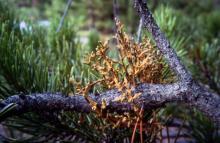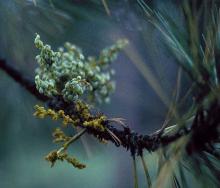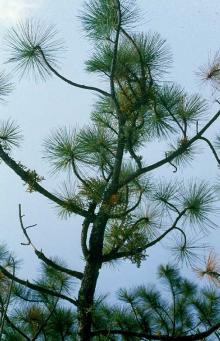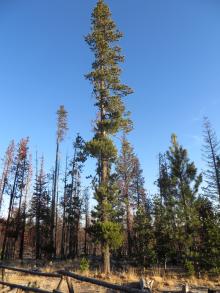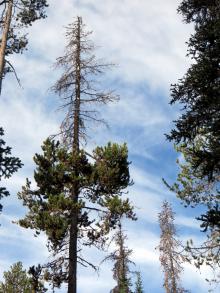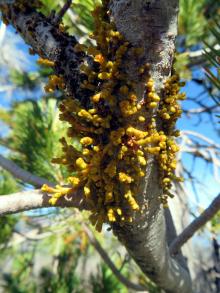By M. Agne
Cause Many pine species in Oregon are affected by various species of dwarf mistletoes (Arceuthobium spp.), which are parasitic flowering plants. Highly host-specific, each dwarf mistletoe species typically has one or two primary host species and only occasionally infects other hosts. Western dwarf mistletoe (A. campylopodum) is a widespread disease of ponderosa pine, infects Jeffrey pine where it occurs in southwestern Oregon, and occasionally infects lodgepole pine. Lodgepole pine dwarf mistletoe (A. americanum) is very common throughout the range of lodgepole pine, and also occasionally infects ponderosa, whitebark, and Jeffrey pines. A. americanum does not infect shore pine, however shore pine dwarf mistletoe (A. tsugense subsp. contortae) is found in British Columbia and the San Juan Islands of Washington state. Knobcone pine dwarf mistletoe (A. siskiyouense) is known to occur on an inland population of shore pine north of Cave Junction, Oregon as well as on knobcone pine in the Klamath and Siskiyou Mountains. Limber pine dwarf mistletoe (A. cyanocarpum) is found on whitebark pine in the Cascade Range and near Crater Lake; it is also occasionally found on western white pine. Western white pine dwarf mistletoe (A. monticola) occurs on western white pine in southwestern Oregon and is locally endemic there.
Dwarf mistletoe seeds spread by explosive discharge and have the ability to disperse up to 50 feet, although they are more commonly intercepted by host needles within 10 feet. After adhering to tree needles, the seed is washed down to the twig where germination and infection occur. Branch swellings at the site of infection often form within 1 to 2 years. Dwarf mistletoe requires an incubation time of 3 to 5 years prior to the emergence of aerial shoots, although incubation times of up to 8 years have been observed. Pollination of female plants, fruit production and dispersal often occur 2 to 3 years after the emergence of aerial shoots. Overall, dwarf mistletoe spreads into uninfected areas at a rate of about 2 feet/year.
Severe infection by dwarf mistletoe causes large losses of timber by slowing both height and diameter growth, degrading wood quality, and increasing the risk of mortality. Severe infection may also lead to increased host susceptibility to crown fire and insect attack, as well as decreased cone and seed production. Advance regeneration is often infected in these stands so clear-cutting alone is insufficient. Due to long life-cycle and dispersal mechanism, recolonization of dwarf mistletoe in sanitized stands happens very slowly.
Dwarf mistletoe shoots and brooms provide habitat and resources for many species of birds, mammals, insects, and arachnids, and have been shown to increase biodiversity in certain forest types.
Symptoms Yellow to light green plants occur at the site of infection, ranging in height from 1 to 4 inches depending on species. Plants form most often on pine branches, but may also be found on the trunk of the host. Branch swellings at points of infection are common. Witches' brooms, abnormally shaped, compact, dense, branches are common in infected trees. Top-kill and loss of uninfected branches in the crown is often associated with the presence of witches' brooms.
Cultural control
- Prune infected branches of lightly infected trees. Pruning is ineffective in severely infected trees.
- Remove severely infected trees where uninfected, susceptible trees are nearby.
Forestry
- Clear-cut and burn severely infected stands to remove dwarf mistletoe completely.
- Favor non-hosts where appropriate.
- Minimize the retention of heavily infected overstory leave-trees.
- Cut and thin heavily infected understory trees.
- Plant non-host trees around infection areas or around heavily infected leave-trees.
- Favor non-hosts where appropriate.
- Creating gaps where heavily infected trees are aggregated.
Reference Hawksworth, F.W. and Wiens, D. 1996. Dwarf Mistletoes: Biology, Pathology and Systematics. Agricultural Handbook 709. Washington, DC: USDA Forest Service.

